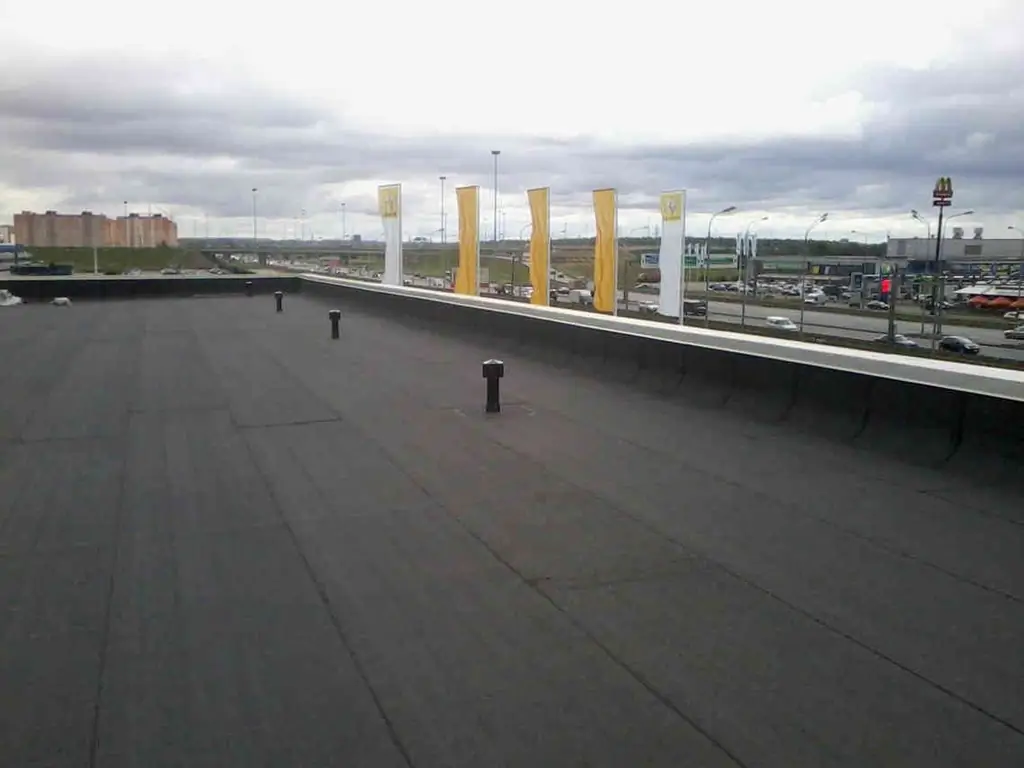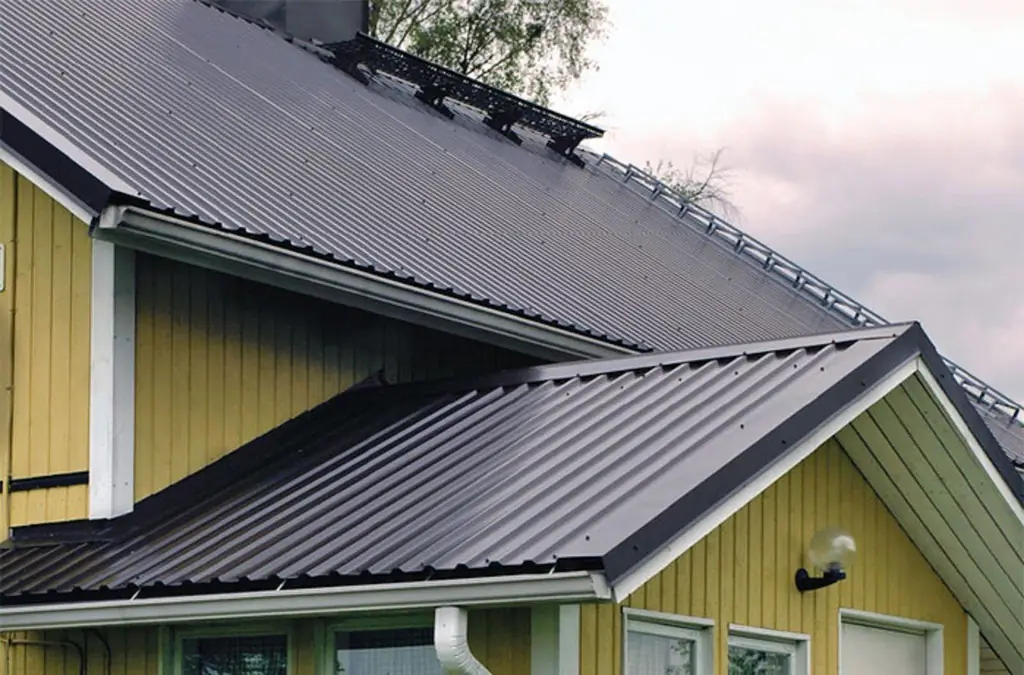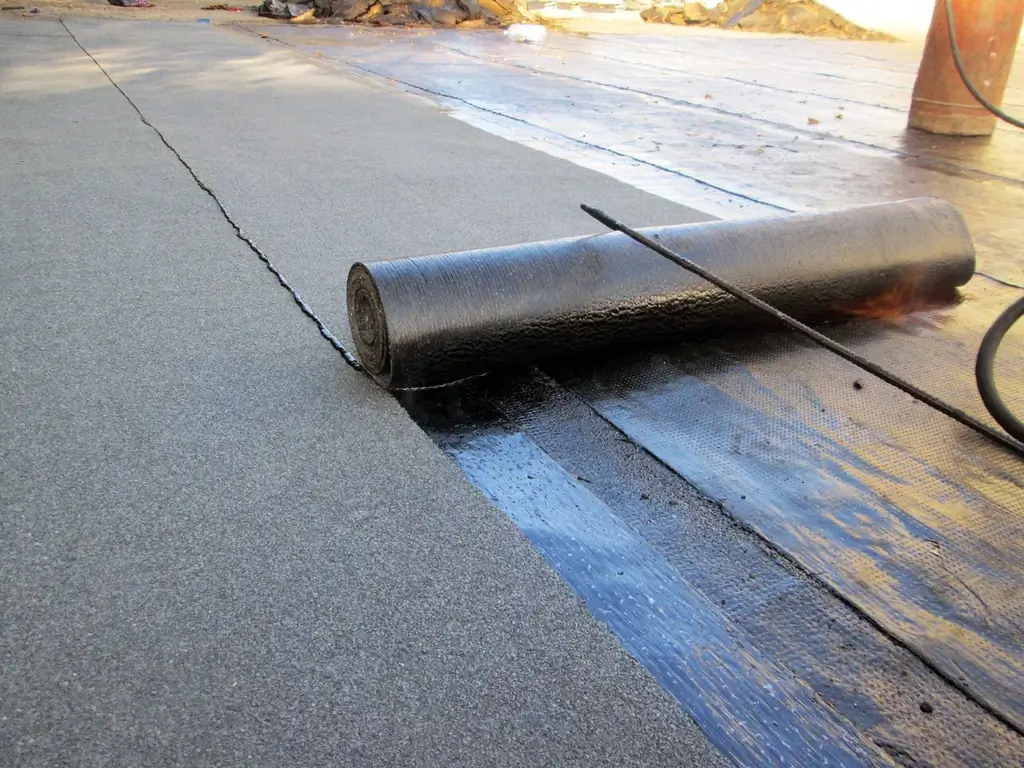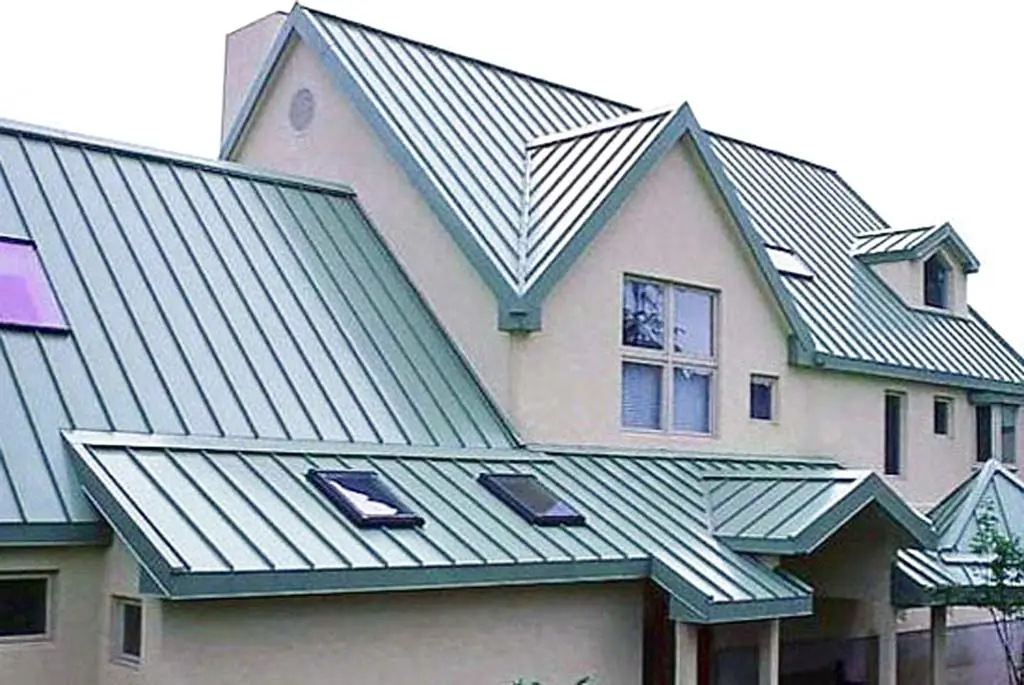
Table of contents:
- Author Bailey Albertson [email protected].
- Public 2023-12-17 12:53.
- Last modified 2025-06-01 07:32.
Characteristics and structure of seam roofing, features of its repair and operation

Seam roofing can be made of either sheet or roll metal. Its feature is the presence on the edges of the sheets of a special lock - a fold, with which they are connected. When creating a fold, the edges of one sheet are wrapped in a special way and cover the folded edge of the other sheet. To obtain a reliable and tight connection, a special tool is used to seal the joint.
Content
-
1 Seam roofing: its features and characteristics
- 1.1 A bit of history
-
1.2 Characteristics of standing seam roofs
1.2.1 Video: the advantages of seam roofing
- 1.3 Material for standing seam roofing with description and characteristics
-
2 Tools for standing seam roof
- 2.1 Hand-held roofing tool
- 2.2 Semi-automatic seamers
- 2.3 Electric folding machines
- 2.4 Portable roll forming machines
- 2.5 Video: Tool Used to Create Seam Roofs
- 3 Device of seam roof
-
4 Features of mounting a seam roof
- 4.1 Video: Seam Roof - Installation Overview
- 4.2 Errors when installing a seam roof
-
5 Features of operating seam roofing
- 5.1 Service life of standing seam roof
- 5.2 Repair of seam roofs
Seam roofing: its features and characteristics
The seam roof not only reliably protects the building from the negative effects of precipitation and other external factors, but also provides it with a solid and attractive appearance. The bonding of the roofing sheets is durable and provides a hermetic coating for many decades.

Seam roofing is a reliable and airtight covering and gives the whole building a presentable appearance
A bit of history
At first, seam roofing was made only from copper sheets. This is due to their resistance to corrosion, as well as their softness, which made it easy to work with such a material. The only drawback of such a roof was its high cost.
With the development of metal processing technologies, sheets began to be made from plain and galvanized steel, which made them accessible to ordinary people. Now copper roofing is also used, but rarely - because of the high cost of the material. Nowadays, a seam roof with self-locking locks is popular, which allow you to install it yourself, without the use of special tools and equipment.
At first, metal strips protected against corrosion only with paint, but this was enough for several years and the roof had to be painted again. Over time, galvanized iron appeared, its service life increased, but the cost of the material also increased. Today, an effective and reliable anti-corrosion protection for steel is a polymer coating. It not only reliably protects the metal base, but also allows you to make the roof of different colors. The cost of polymer coated material is lower than that of galvanized sheets.
Seamed roof characteristics
In Europe, seam roofing has long gained well-deserved popularity, but here it is just beginning to gain popularity. Before proceeding with the description of the technical characteristics of the seam roof, you first need to understand the terminology used by specialists:
- rebate - a special lock connection that ensures high tightness. It is maintainable;
- pictures are elements in the form of sheets or strips of metal, which are interconnected with locks;
- cleat - a fastening element with which the paintings are fixed to the roof lathing. It can be movable (for sheets with a length of more than 6-10 m), allowing to compensate for the expansion of the metal and fixed (for sheets with a length of less than 6 m).
A seam or a fold can be standing or lying, double or single. For the design of the transverse joint, a standing seam is used, and for the longitudinal joint, a recumbent seam. The seam can be self-locking, but if it needs to be rolled, then special devices or tools are used for fixing and sealing. The double construction provides the greatest protection against moisture and maximum sealing of the seam.

The longitudinal connection is made with a standing seam, and the transverse one with a recumbent
The main advantages of standing seam roofing:
- the absence of holes in the metal, providing greater reliability and durability;
- high moisture resistance of the seam;
- small mass, which eliminates the need to create a reinforced rafter structure;
- versatility - the material is suitable for covering roofs of any configuration, both flat and complex shapes;
- a wide range of colors of materials, allowing you to choose such a coating for any home design;
- incombustibility;
- maintainability and ease of maintenance.
This technology has its drawbacks:
- if you have not purchased sheets with self-locking elements, only qualified roofers with special tools can perform the installation;
- since the surface is metal, it must be properly and efficiently insulated;
- it is necessary to provide good sound insulation, since noise will be heard in the house during rain;
- since metal accumulates a static charge, lightning rods and grounding must be installed to protect against lightning;
- since the roof is smooth and slippery, accumulated snow easily rolls off it, so it is imperative to install snow guards.
Before buying, make sure that the technical characteristics of the material meet your requirements, since only a competent choice and high-quality installation of roofing material will ensure its reliable and durable service
Video: the advantages of a seam roof
Seam roofing material with description and characteristics
Both rolled and sheet metal are used to create a seam roof. Usually its thickness is 0.5-0.7 mm, which makes it possible to make a sealed lock and provides the necessary strength and rigidity.
Most often, the following metals are used for the manufacture of a seam roof:
-
Steel. It can be galvanized or not galvanized, it may need additional painting or be covered with a polymer material. The lifespan of the roof will depend on the thickness of the anti-corrosion coating. Most often, the metal is coated with polymers, but their disadvantage is that, under the influence of solar radiation, the metal quickly loses its original color.

Steel seam roof Seam roofing is most often made from a thin steel sheet
-
Aluminum. This metal has high corrosion resistance and low weight. Such sheets are attached only to floating clamps, since aluminum has a high coefficient of expansion. Usually the sheet thickness is 0.7 mm.

Aluminum rebated roof Aluminum sheets have high anti-corrosion resistance and a significant coefficient of thermal expansion, so they are installed only on clamps
-
Copper. This metal is lighter, more beautiful and softer than steel, therefore it is easier to cover embossed surfaces with it. At first, the leaves shine in the sun, but over time the copper oxidizes and darkens, and then becomes covered with a noble greenish coating - a patina. Scratches are very noticeable on polished metal, so you need to be very careful during installation. The main disadvantage of copper is its high cost, but it is fully compensated by its long service life.

Copper seam roof Over time, copper sheets oxidize, from which they first darken, and then become covered with a patina
-
Zinc titanium. It is a relatively new material that consists of zinc, titanium, aluminum and copper. Over time, it does not lose its original appearance. If necessary, it can be easily repaired, for example, soldered with tin. The main disadvantage of zinc-titanium roofing is its high cost. In addition, it is very moody during installation, so only specialists should install such a roof. Zinc-titanium paintings are laid on a continuous crate, while they should not come into contact with copper, steel and wooden elements from oak and larch. Waterproofing is not installed for this roof, and it can only be installed at an air temperature of more than 7 o C.

Zinc-titanium rebated roof Zinc-titanium is a modern material that retains its protective properties throughout its entire service life
Seam roofing tool
To carry out the installation of a seam roof, you must have special tools and equipment, without which it will not be possible to perform the indicated work. When using self-locking folds, additional tools can be dispensed with, since it is enough to press it well to fix the seam.
Manual roofing tool
Any professional has up to 40 tools in his arsenal that he needs to get the job done well. The hand-held roofing tool is used for rolling horizontal seams, joining the roof to skylights, chimneys, ridge, etc. To install a seam roof, you will need the following tools:
- mallet - rectangular and wedge-shaped;
- scissors for metal for straight and curved cuts;
- roofing mandrel;
- seam hammer;
- straight and curved pliers;
- ticks;
-
folded chalasen.

Folded chalasen Folded chalasen is used for making standing seam
In addition, you will need a special hand tool called frames or haps. It is used to create a double standing seam in two steps. One of the most popular manufacturers of such tools is STUBAI-Tooling Industries (Austria).

This specialized roofing tool is called "frames" and is used to create a double standing seam
Semi-automatic seamers
With the help of a semi-automatic tool, installation is easier and faster. It allows you to create a double standing seam. With the use of such a tool, work is performed quickly, the quality of the seam is uniform, and depending on the settings, you can work with metal of different thicknesses. Seamers are most effective when laying roll material on long slopes, and they also do not damage the polymer coating.

Semi-automatic seaming machines allow you to quickly seal seams on long slopes
Electric folding machines
When using electric seaming machines, an even seam is obtained in one pass, while requiring minimal human intervention. With electrical equipment, you can easily work with rigid roofing material.
The most famous manufacturers of electric folding machines are such companies as Wuko (Austria), Dimos (France), Ytor (Sweden), Draco (Germany), CA GROUP Limited (UK), Mobiprof (Russia).

Electric folding machines require minimal human intervention and allow you to work quickly and efficiently
Portable roll forming machines
The profiling machines allow you to make a seam roof from rolled steel without horizontal seams. The machine and strip are delivered to the construction site, where pictures of the required length with vertical double seam are immediately rolled.
All connecting parts used during the installation of a seam roof must be made of the same material as the base covering
There are machines for creating self-locking seams, in this case no additional tools are needed. It is enough to lay and fix the sheets, then press on the fold, and it will click into place.

Portable roll forming machines enable the required length of rebate on site
Video: a tool used to create a seam roof
Seam roof device
The folded roof is very robust and ensures maximum roof tightness. To create a seam roof, metal sheets (pictures) are used, for which the sides are specially prepared. If we talk about the types of seam panels, then they can be:
-
trapezoidal or parallel;

Trapezoidal and parallel fold Trapezoidal rebate has additional ribs 4-5 mm high, which increase the rigidity of the sheet
-
starting or privates. At the starting panel, both edges have an internal bend, for the private one - the right one is curved in the opposite direction and is superimposed on the panel lying next to it for connection to the lock;

Start and regular seam panel The start panel is installed first from the edge of the roof, and the privates are used for further installation
-
with self-latching lock;

Seam panel with self-latching lock To fix the self-latching lock, just press it with your foot
-
with or without ribs.

Ribbed seam panel The presence of ribs on the self-locking panel increases its rigidity
When installing a seam roof, the following additional elements are used:
- ridge bar;
- endova;
- cornice strip;
- end plate;
- abutment bar.
When making an estimate, do not forget to include in it the cost of all additional elements, clamps and other fasteners. In order for the roof to function fully and fulfill its purpose, it must be installed on it:
- elements of the drainage system. They are needed to organize effective drainage of water from the roofing;
- ventilation outlets. They will help to ensure adequate ventilation so that the resulting condensation does not damage metal and wooden elements of the roof;
- protective elements - snow protectors and lightning rods, which protect the coating from damage, and the people living in the house and those near it, from injury and electric shock.
The device of a seam roof implies the installation of all the necessary additional elements, this cannot be neglected

The seam roof device implies the presence of snow holders, gutters and other additional elements
The device of a high-quality, well-insulated and sound-insulated folded roof implies the presence of the following elements:
- rafter system;
- the crate to which the roofing material is attached;
- folded sheets;
- clamps for fixing roofing material;
- counter-lattice;
- a waterproofing layer between the insulation and the roofing material;
- insulation;
- vapor barrier between interior decoration and insulation;
- end plate at the ends of the roof;
-
ridge bar at the junction of two slopes.

Seam roof device In order for the seam roofing to work as efficiently as possible, it must be properly insulated and soundproofed
Features of mounting a seam roof
Carrying out the installation of a seam roofing provides for the careful execution of all stages. Sheets can only be transported in an upright position, and they are fed to the roof along boards to prevent bending. The lathing should be even, the permissible slope of the slope is more than 7 degrees.
The work is carried out in the following sequence:
-
Installation of battens. At angles of inclination of up to 14 o, manufacturers recommend laying seam roofing on a continuous sheathing. On steeper slopes, a sparse base can be used in increments of no more than 40 cm.

Sheathing for seam roofing On small slopes under a folded roof, it is imperative to arrange a continuous crate, at angles greater than 14 degrees, you can make a sparse one, but with a step of no more than 40 cm
- Fastening the eaves. Before laying the sheets, the cornice strips are fixed. They are nailed 35 mm above the lathing and are attached with galvanized nails.
- Laying the first sheet. When editing the first sheet, you need to be especially careful. The sheet should protrude 10 cm above the eaves. The sheet is aligned both vertically and horizontally so that the angle between it and the cornice is 90 o. The start panel is used as the first sheet.
-
Fixing the first sheet. If there are holes in the sheet, then it is attached to the crate with self-tapping screws, if not, then the fastening is performed using clamps. The step between the bindings should not exceed 50 cm.

Clamps for folded sheets The clamp is attached to the lathing at three points and reliably presses the picture by its side edge, which eliminates the need to make holes in the coating itself
-
Installation of the second sheet. Its edges are aligned with the edges of the first picture, and the opposite edge is fixed to the lathing.

Installation of rebated roof sheets One edge of the picture is combined with the previous sheet, and the second is fixed to the crate with clamps
- Fold lock. With the help of special tools, a single or double fold is created.
- Device for abutting the eaves. The edges of the sheets that protrude beyond the cornice are folded over and hidden under the additional strip. If they turn out to be very large, then the sheet is cut off.
-
Installation of additional elements. To cover the ridge, valleys and junctions, you can buy ready-made elements or make them yourself. They are also connected with a fold.

Laying the ridge strip Installation of a seam roof is completed with the installation of a ridge additional element
To bend the folds, it is better to use semi-automatic or automatic devices, since only a master can make a high-quality connection with a hand tool. The overlap of the sheets should be about 20 cm, and their offset relative to the previous row should be half the width of the picture.
Video: seam roof - installation overview
Errors when installing a seam roof
When self-installing a folded roof, you can make some mistakes that will lead to a violation of the tightness of the coating, which will significantly reduce its service life:
-
Violation of the painting technology. When installing a standing seam roof, special attention should be paid to the quality of the joining of paintings. Reliable sealing of the rebate will only be achieved if it is correctly snapped into place. If the lock is self-latching, then it just needs to be tightly closed, otherwise, when seaming the seam, hand tools or seaming machines must be used correctly.

Errors when installing a seam roof Double standing seam is the most reliable type of joining pictures, but to use it you need to be able to use a specialized tool
- Incorrect stacking of paintings. Sheets must be laid only along the slope, usually they are ordered in full length or made directly on the construction site. If the pictures are short, then a horizontal fold is used to join them.
- The crate is not made correctly. The lathing should be as even as possible, otherwise the metal will "walk", gradually destroying the seam seam. It is not necessary to make too massive sheathing, since the weight of the seam roof is small.
Errors made during the installation of a seam roofing lead to the appearance of leaks, a violation of the sound insulation of the roof and its freezing
Features of operating seam roofing
During the operation of the seam roof, it is necessary to carry out periodic inspections, it is better to do this during or immediately after rain, so it is easier to identify leaks. If problem areas appear, they are noted and repaired.
If you have a galvanized roof, experts recommend painting it once every 10 years. Please note that from the inside, such a roof rusts faster, so you may need to paint it earlier. If the roof is not galvanized, then it will have to be painted every 3-4 years.

If non-galvanized steel is used, then the roof will have to be painted every 3-4 years
Service life of standing seam roof
For the manufacture of seam roofing, different materials can be used, therefore, the service life of the coating will differ:
- steel sheets - 15-40 years depending on the type of coating. To extend the service life, polymeric materials such as pural, purex, polyester are used;
- aluminum paintings - 80-100 years old;
- copper roof - 100 years or more;
- zinc-titanium sheets - not less than 100-150 years.
Seam roof repair
There can be many reasons for leaking seam roofs. If it has been in operation for a long time, such factors can have a negative impact:
- sagging or bending of the rafter system;
- wear of sheets;
- cracks in the places where the roof adjoins to chimneys, ventilation shafts and other vertical elements due to frequent freezing and thawing;
- mechanical damage to the roofing material;
- a large step of the crate;
- incorrect folded joint.
Restoration work begins with an inspection of the roof from the attic side. If you determine that the seam is leaking, you need to re-roll it, and use silicone sealant to improve the tightness. If the reason is damage to the rafter system, then spot repairs cannot be done, you will have to overhaul the roof. In this case, it is also better to replace the roofing material.

If corrosion and rust appears on metal sheets, as well as damage to the rafter system, it is necessary to overhaul the roof
When the reason lies in the appearance of mechanical damage in the form of holes, the whole picture must be replaced. To dismantle it, you will need a special tool with which the folds are unbent. Then the old sheet is removed, a new one is installed and the seams are rolled up.
If the roof is aluminum or copper, the hole can be soldered. For additional sealing of the folds, you can use special butyl rubber tapes or cords. Please note that conventional rubber sealant loses its properties at temperatures above 90 o C, so if the house is located in the southern region, then a high temperature sealant should be used.
To increase the strength of the seam, the horizontal folds are tapped with a mallet, and the vertical folds are opened and rolled again. If rust appears, then it must be dealt with at the very initial stages. It is cleaned off with a brush, and then the problem area is covered with special compounds, for example, "Anticorrosive", "Rust converter" or others. After they dry, the surface is painted.
The roof is one of the basic elements of any home. If you decide to make seam roofing and do not have the necessary skills, it is better to invite specialists to perform such work. Only correct and competent installation, which requires special tools and equipment, will create a strong, reliable and durable coating.
Recommended:
The Welded Roof, Including The Features Of Its Construction, Operation And Repair, As Well As How To Avoid Mistakes During Installation

The main features and characteristics of the overlaid roof. Materials and tools required for the job. Installation, operation and repair of the overlaid roof
Roofing From A Profiled Sheet, Including The Features Of Its Design And Operation, Repair, As Well As How To Avoid Mistakes During Installation

What kind of profiled sheet can be used for the roof. DIY cold and insulated roof device. What mistakes are possible. Features of operation and repair
Polycarbonate Roofing, Including The Features Of Its Construction, Operation And Repair, As Well As How To Avoid Mistakes During Installation

Characteristics of polycarbonate as a roofing material. How to make a polycarbonate roof with your own hands. Features of operation and repair. Photo and video
Roll Roofing, Including The Features Of Its Construction, Operation And Repair, As Well As How To Avoid Mistakes During Installation

The difference between roll roofing and modern and Soviet counterparts. Can I use roll roofing on a pitched roof? How to install it and when to repair it
Roofing Made Of Corrugated Board, Including The Features Of Its Design And Operation, Repair, As Well As How To Avoid Mistakes During Installation

Features and characteristics of corrugated roofing. Types of roofing sheeting. Calculation of the amount of material for the roof. Features of installation and operation
